Toyota Yaris 2005 Owner's Manual

04 05.18
SECTION 1−1
OPERATION OF INSTRUMENTS AND
CONTROLS
Overview of instruments and controls
Instrument panel overview . . . . . . . . . . . . . . . . . . . . . . . . . . . . . . . . . . . . . 2
Instrument cluster overview . . . . . . . . . . . . . . . . . . . . . . . . . . . . . . . . . . . . 4
Indicator symbols on the instrument panel . . . . . . . . . . . . . . . . . . . . . . . 5
2005 ECHO HATCHBACK from Jul. ’04Prod. (OM52624U) |
1 |
|
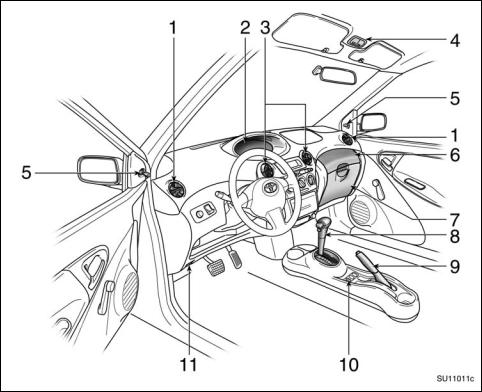
04 05.18
Instrument panel overview
1. Side vents
2. Instrument cluster
3. Center vents
4. Personal lights
5. Rear view mirror remote control levers
6. Auxiliary box
7. Glove box
8. Automatic transmission selector lever or manual transmission gear shift lever
9. Parking brake lever
10. Power door lock switch
11. Hood lock release lever
2 |
2005 ECHO HATCHBACK from Jul. ’04Prod. (OM52624U) |
|

04 05.18
1. |
Headlight and turn signal switches |
|||
2. |
Wiper |
and washer |
switches |
|
3. |
Rear |
window defogger switch |
|
|
4. |
Emergency flasher |
switch |
|
|
5. |
Air conditioning controls |
|
||
6. |
Front |
passenger’s |
seat belt |
reminder |
|
light |
|
|
|
7. |
Cigarette lighter |
|
|
|
8. |
Ashtray |
|
|
|
9. |
Ignition switch |
|
|
|
10. |
Tilt steering lock release lever |
|||
11. |
Instrument panel light control |
knob |
||
2005 ECHO HATCHBACK from Jul. ’04Prod. (OM52624U) |
3 |
|

04 05.18
Instrument cluster overview
1. |
Service reminder indicators and |
4. |
Odometer and two trip meters |
6. |
Trip meter reset button |
|
|
indicator lights |
5. |
Fuel gauge |
7. |
Tachometer |
|
2. |
Speedometer |
|||||
|
|
|
|
|||
3. |
Extinction canceling button |
|
|
|
|
4 |
2005 ECHO HATCHBACK from Jul. ’04Prod. (OM52624U) |
|
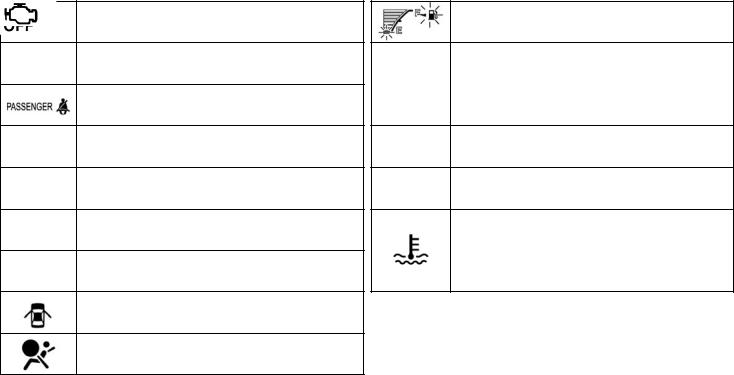
04 05.18
Indicator symbols on the instrument panel
Brake system warning light 1
Driver’s seat belt reminder light 1
Front passenger’s seat belt reminder light 1
Discharge warning light 1
Malfunction indicator lamp 1
Low engine oil pressure warning light 1
Anti-lock brake system warning light 1
Open door warning light 1
SRS warning light 1
Low fuel level indicator light 1
Low |
windshield washer fluid level warning |
light 1 |
|
Turn |
signal indicator lights |
Headlight high beam indicator light
Overdrive−off indicator light
Low engine coolant temperature indicator light (in blue) 2
High engine coolant temperature warning light (in red) 1
1: For details, see “Service reminder indicators and warning buzzers” in Section 1−6.
2: For details, see “Engine coolant temperature indicator and warning light” in Section 1−6.
2005 ECHO HATCHBACK from Jul. ’04Prod. (OM52624U) |
5 |
|
04 05.18
6 |
2005 ECHO HATCHBACK from Jul. ’04Prod. (OM52624U) |
|

04 04.06
SECTION 1−2
OPERATION OF INSTRUMENTS AND
CONTROLS
Keys and Doors
Keys . . . . . . . . . . . . . . . . . . . . . . . . . . . . . . . . . . . . . . . . . . . . . . . . . . . . . . . . 8
Side doors . . . . . . . . . . . . . . . . . . . . . . . . . . . . . . . . . . . . . . . . . . . . . . . . . . . 8
Back door . . . . . . . . . . . . . . . . . . . . . . . . . . . . . . . . . . . . . . . . . . . . . . . . . . . 10
Hood . . . . . . . . . . . . . . . . . . . . . . . . . . . . . . . . . . . . . . . . . . . . . . . . . . . . . . . 11
Fuel tank cap . . . . . . . . . . . . . . . . . . . . . . . . . . . . . . . . . . . . . . . . . . . . . . . 12
2005 ECHO HATCHBACK from Jul. ’04Prod. (OM52624U) |
7 |
|

04 04.06
Keys |
|
|
Side doors— |
||
|
|
|
|
|
|
|
|
|
|
|
|
These keys work in every lock.
Since the side doors and back door can be locked without a key, you should always carry a spare key in case you accidentally lock your keys inside the vehicle.
KEY NUMBER PLATE
Your key number is shown on the plate. Keep the plate in a safe place such as your wallet, not in the vehicle.
If you should lose your keys or if you need additional keys, duplicates can be made by a Toyota dealer using the key number.
We recommend writing down the key number and storing it in a safe place.
LOCKING AND UNLOCKING WITH KEY
Insert the key into the keyhole and turn it.
To lock: Turn the key forward.
To unlock: Turn the key backward.
5−door models—All the side doors and back door lock and unlock simultaneously with either front door. In the driver’s door lock, turning the key once will unlock the driver’s door and twice in succession will unlock all the side doors and back door simultaneously.
8 |
2005 ECHO HATCHBACK from Jul. ’04Prod. (OM52624U) |
|

04 04.06
LOCKING AND UNLOCKING WITH INSIDE LOCK BUTTON
Move the lock button.
To lock: Push the knob down. To unlock: Pull the knob up.
Closing the door with the lock knob in the lock position will also lock the door. Be careful not to lock your keys in the vehicle.
LOCKING AND UNLOCKING WITH POWER DOOR LOCK SWITCH
(5−door models only) Push the switch.
To lock: Push the switch down on the “LOCK” side.
To unlock: Push the switch down on the “UNLOCK” side.
All the side doors and back door lock or unlock simultaneously.
However, once you lock the back door by a key, you can unlock the back door only by the key.
REAR DOOR CHILD−PROTECTORS (5−door models only)
Move the lock lever to the “LOCK” position as shown on the label.
When the child−protector is locked, you cannot open the rear door by the inside door handle. We recommend using this feature whenever small children are in the vehicle.
2005 ECHO HATCHBACK from Jul. ’04Prod. (OM52624U) |
9 |
|
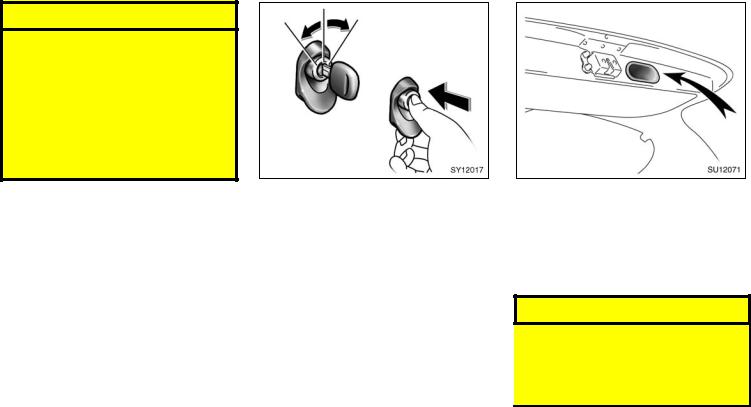
04 04.06
 CAUTION
CAUTION
Before driving, be sure that the doors are closed and locked, especially when small children are in the vehicle. Along with the proper use of seat belts, locking the doors helps prevent the driver and passengers from being thrown out from the vehicle during an accident. It also helps prevent the doors from being opened unintentionally.
Back door
LOCKING AND UNLOCKING WITH KEY
Insert the key into the keyhole and turn it.
To lock: Turn the key clockwise.
To unlock: Turn the key counterclockwise.
5−door models—
Operating the power door lock switch simultaneously locks or unlocks the back door (see “Side doors” on page 8).
However, once you lock it by a key, you can unlock it only by the key.
See “Cargo and luggage” on page 120 in Section 2 for precautions to observe when loading luggage.
When closing the back door, the inside handle can be used to make the reach easier.
To close the back door, lower it and press down on it. After closing the back door, try pulling it up to make sure it is securely closed.
 CAUTION
CAUTION
Keep the back door closed while driving. This not only keeps the luggage from being thrown out but also prevents exhaust gases from entering the vehicle.
10 |
2005 ECHO HATCHBACK from Jul. ’04Prod. (OM52624U) |
|
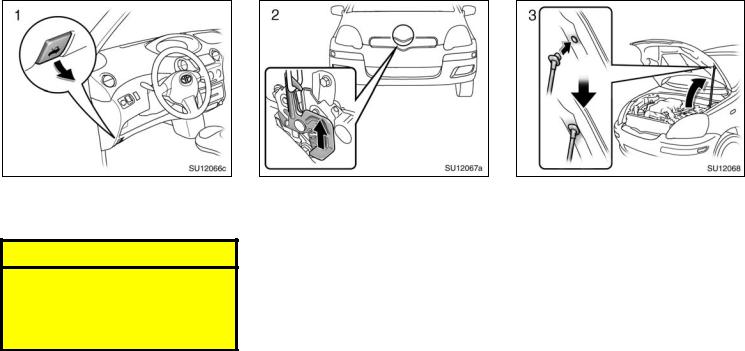
04 04.06
Hood
To open the hood:
1. Pull the hood lock release lever. The hood will spring up slightly.
 CAUTION
CAUTION
Before driving, be sure that the hood is closed and securely locked. Otherwise, the hood may open unexpectedly while driving and an accident may occur.
2.In front of the vehicle, pull up the auxiliary catch lever and lift the hood.
3.Hold the hood open by inserting the support rod into the slot.
To insert the support rod into the slot, move it straight up. If it is moved to the side or toward the inside of the vehicle, it may become detached.
Before closing the hood, check to see that you have not forgotten any tools, rags, etc. and return the support rod to its clip− this prevents rattles. Then lower the hood and make sure it locks into place. If necessary, press down gently on the front edge to lock it.
2005 ECHO HATCHBACK from Jul. ’04Prod. (OM52624U) |
11 |
|

04 04.06
Fuel tank cap
 CAUTION
CAUTION
After inserting the support rod into the slot, make sure the rod supports the hood security from falling down on to your head or body.
NOTICE
Be sure to return the support rod to its clip before closing the hood. Closing the hood with the support rod up could cause the hood to bend.
This |
indicates that the fuel filler door |
is on |
the left side of your vehicle. |
1.To open the fuel filler door, pull the lever up.
When refueling, turn off the engine.
 CAUTION
CAUTION
D Do not smoke, cause sparks or allow open flames when refueling. The fumes are flammable.
DWhen opening the cap, do not remove the cap quickly. In hot weather, fuel under pressure could cause injury by spraying out of the filler neck if the cap is suddenly removed.
12 |
2005 ECHO HATCHBACK from Jul. ’04Prod. (OM52624U) |
|
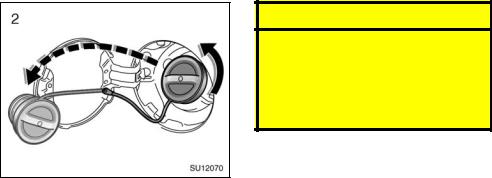
04 04.06
 CAUTION
CAUTION
D Make sure the cap is installed securely to prevent fuel spillage in the event of an accident.
D Use only a genuine Toyota fuel tank cap for replacement. It is designed to regulate fuel tank pressure.
2. To |
remove the fuel tank cap, turn |
the |
cap slowly counterclockwise, |
then pause slightly before removing it. After removing the cap, hang the tether as shown in the illustration.
It is not unusual to hear a slight swoosh when the cap is opened. When installing, turn the cap clockwise till you hear a click.
If the cap is not tightened securely, the malfunction indicator lamp comes on. Make sure the cap is tightened securely.
The indicator lamp goes off after driving several times. If the indicator lamp does not go off, contact your Toyota dealer as soon as possible.
2005 ECHO HATCHBACK from Jul. ’04Prod. (OM52624U) |
13 |
|
04 04.06
14 |
2005 ECHO HATCHBACK from Jul. ’04Prod. (OM52624U) |
|

04 05.28
SECTION 1−3
OPERATION OF INSTRUMENTS AND
CONTROLS
Occupant restraint systems
Seats . . . . . . . . . . . . . . . . . . . . . . . . . . . . . . . . . . . . . . . . . . . . . . . . . . . . . . 16
Front seats . . . . . . . . . . . . . . . . . . . . . . . . . . . . . . . . . . . . . . . . . . . . . . . . . 16
Fold−down rear seat . . . . . . . . . . . . . . . . . . . . . . . . . . . . . . . . . . . . . . . . . 19
Head restraints . . . . . . . . . . . . . . . . . . . . . . . . . . . . . . . . . . . . . . . . . . . . . . 20
Seat belts . . . . . . . . . . . . . . . . . . . . . . . . . . . . . . . . . . . . . . . . . . . . . . . . . . . 21
SRS driver and front passenger airbags . . . . . . . . . . . . . . . . . . . . . . . . 28
Child restraint . . . . . . . . . . . . . . . . . . . . . . . . . . . . . . . . . . . . . . . . . . . . . . . 35
2005 ECHO HATCHBACK from Jul. ’04Prod. (OM52624U) |
15 |
|

04 05.28
Seats
While the vehicle is being driven, all vehicle occupants should have the seatback upright, sit well back in the seat and properly wear the seat belts provided.
Seating capacity:
Total 4 (Front 2, Rear 2)
 CAUTION
CAUTION
DDo not drive the vehicle unless the occupants are properly seated. Do not allow any passengers to sit on top of a folded−down seatback, or in the luggage compartment or cargo area. Persons not properly seated and/or not properly restrained by seat belts can be severely injured in the event of emergency braking or a collision.
DDuring driving, do not allow any passengers to stand up or move around between seats. Otherwise, severe injuries can occur in the event of emergency braking or a collision.
Front seats—
—Front seat precautions
Driver seat
 CAUTION
CAUTION
The SRS driver airbag deploys with considerable force, and can cause death or serious injury especially if the driver is very close to the airbag. The National Highway Traffic Safety Administration (“NHTSA”) advises:
Since the risk zone for driver airbag is the first 50−75 mm (2−3 in.) of inflation, placing yourself 250 mm (10 in.) from your driver airbag provides you with a clear margin of safety. This distance is measured from the center of the steering wheel to your breastbone. If you sit less than 250 mm (10 in.) away now, you can change your driving position in several ways:
D Move your seat to the rear as far as you can while still reaching the pedals comfortably.
D Slightly recline the back of the seat. Although vehicle designs vary, many drivers can achieve the 250 mm (10 in.) distance, even with the driver seat all the way forward, simply by reclining the back of the seat somewhat. If reclining the back of your seat makes it hard to see the road, raise yourself by using a firm, non−slippery cushion, or raise the seat if your vehicle has that feature.
DIf your steering wheel is adjustable, tilt it downward. This points the airbag toward your chest instead of your head and neck.
The seat should be adjusted as recommended by NHTSA above, while still maintaining control of the foot pedals, steering wheel, and your view of the instrument panel controls.
16 |
2005 ECHO HATCHBACK from Jul. ’04Prod. (OM52624U) |
|

04 05.28
Front passenger seat
 CAUTION
CAUTION
The SRS front passenger airbag also deploys with considerable force, and can cause death or serious injury especially if the front passenger is very close to the airbag. The front passenger seat should be as far from the airbag as possible with the seatback adjusted, so the front passenger sits upright.
—Seat adjustment precautions
 CAUTION
CAUTION
DDo not adjust the seat while the vehicle is moving as the seat may unexpectedly move and cause the driver to lose control of the vehicle.
D Be |
careful that |
the |
seat does not |
hit |
a passenger |
or |
luggage. |
DAfter adjusting the seat position, release the lever and try sliding the seat forward and backward to make sure it is locked in position.
DAfter adjusting the seatback, push your body back against the seat to make sure the seat is locked in position.
DDo not put objects under the seats except for putting them in the auxiliary box. Otherwise, the objects
may interfere with the seat−lock mechanism or unexpectedly push up the seat position adjusting lever and the seat may suddenly move, causing the driver to lose control of the vehicle.
DWhile adjusting the seat, do not put your hands under the seat or near the moving parts. Otherwise, your hands or fingers may be caught and injured.
2005 ECHO HATCHBACK from Jul. ’04Prod. (OM52624U) |
17 |
|

04 05.28
—Adjusting front seats
1. SEAT POSITION ADJUSTING LEVER
Hold the center of the lever and pull it up. Then slide the seat to the desired position with slight body pressure and release the lever.
2.SEATBACK ANGLE ADJUSTING LEVER
Lean forward and pull the lever up. Then lean back to the desired angle and release the lever.
 CAUTION
CAUTION
To reduce the risk of sliding under the lap belt during a collision, avoid reclining the seatback any more than needed. The seat belts provide maximum protection in a frontal or rear collision when the driver and the front passenger are sitting up straight and well back in the seats. If he/she is reclined, the lap belt may slide past his/her hips and apply restraint forces directly to the abdomen. In the event of a frontal collision, the more the seat is reclined, the greater the risk of personal injury.
—Tilting driver’s seatback for rear seat entry
(3−door models)
Lift the seatback release lever—the seatback will tilt forward.
This allows passengers to get into or out of the rear seat easily. After passengers are in, lift up on the seatback.
 CAUTION
CAUTION
After putting back the seatback, try pushing the seatback forward and rearward to make sure it is secured in place.
18 |
2005 ECHO HATCHBACK from Jul. ’04Prod. (OM52624U) |
|

04 05.28
—Moving passenger’s seat for rear seat entry
(3−door models)
Fold−down rear seat
 CAUTION
CAUTION
DAfter putting back the seat, try pushing the seat forward and rearward to make sure it is secured in place.
D Never |
allow anyone to rest their |
foot on the release pedal while the |
|
vehicle |
is moving. |
For easy access to the rear seat:
1. Lift the seatback angle adjusting lever or press the pedal behind the seatback.
The seat will slide forward.
2.Move the seat to the front−most position.
After passengers are in, lift up the seatback and return the seat until it locks.
(A) BEFORE FOLDING REAR SEAT
Make sure the shoulder belt passes through the hanger when folding the seatback down (or returning the seatback to the upright position).
This prevents the shoulder belt from being damaged.
 CAUTION
CAUTION
DDo not operate the seat while the vehicle is moving.
DThe seat belt must be removed from the hanger when the seat belt is in use.
2005 ECHO HATCHBACK from Jul. ’04Prod. (OM52624U) |
19 |
|
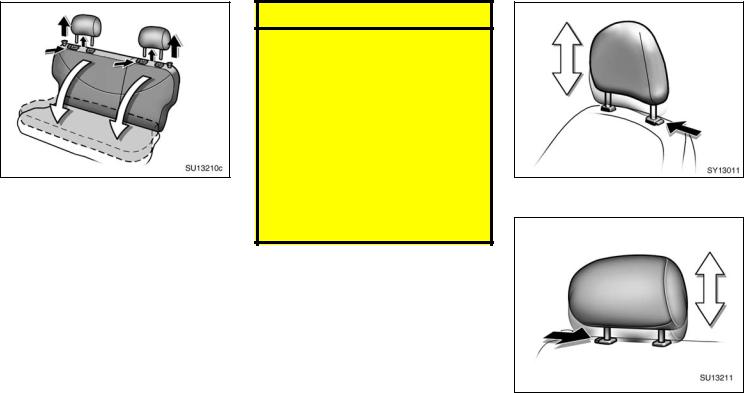
04 05.28
(B) FOLDING REAR SEAT
1.Remove the head restraints.
2.Unlock the seatback, and fold it down.
This will enlarge the luggage compartment as far as the front seatback. See “Cargo and luggage” on page 120 in Section 2 for precautions to observe in loading luggage.
20
 CAUTION
CAUTION
When returning the seatback to the upright position, observe the following precautions in order to prevent personal injury in a collision or sudden stop:
DMake sure the seatback is securely locked by pushing forward and rearward on the top of the seatback. If you removed head restraints, be certain to replace them.
DMake sure the seat belts are not twisted or caught in the seatback and are arranged in their proper position and are ready to use.
Head restraints
Front seat
Rear seat
2005 ECHO HATCHBACK from Jul. ’04Prod. (OM52624U)

04 05.28
For your safety and comfort, adjust the head restraint before driving.
To raise: Pull it up.
To lower: Push it down while pressing the
lock |
release button. |
|
|
||||
The |
head |
restraint |
is most |
effective |
when |
||
it |
is |
close |
to |
your |
head. Therefore, |
using |
|
a |
cushion |
on |
the |
seatback |
is not recom- |
||
mended.
 CAUTION
CAUTION
DAdjust the center of the head restraint so that it is closest to the top of your ears.
DAfter adjusting the head restraint, make sure it is locked in position.
DDo not drive with the head restraints removed.
Seat belts—
—Seat belt precautions
Toyota strongly urges that the driver and passengers in the vehicle be properly restrained at all times with the seat belts provided. Failure to do so could increase the chance of injury and/or the severity of injury in accidents.
The seat belts provided for your vehicle are designed for people of adult size, large enough to properly wear them.
Child. Use a child restraint system appropriate for the child until the child becomes large enough to properly wear the vehicle’s seat belts. See “Child restraint” on page 35 for details.
If a child is too large for a child restraint system, the child should sit in the rear seat and must be restrained using the vehicle’s seat belt. According to accident statistics, the child is safer when properly
restrained |
in the |
rear |
seat than in |
the |
|
front |
seat. |
|
|
|
|
If a |
child |
must sit |
in |
the front seat, |
the |
seat belts should be worn properly. If an accident occurs and the seat belts are not worn properly, the force of the rapid inflation of the airbag may cause death or serious injury to the child.
Do not allow any children to stand up or kneel on either rear or front seats. An unrestrained child could suffer serious injury or death during emergency braking or a collision. Also, do not let the child sit on your lap. Holding a child in your arms does not provide sufficient restraint.
Pregnant woman. Toyota recommends the use of a seat belt. Ask your doctor for specific recommendations. The lap belt should be worn securely and as low as possible over the hips and not on the waist.
Injured person. Toyota recommends the use of a seat belt. Depending on the injury, first check with your doctor for specific recommendations.
2005 ECHO HATCHBACK from Jul. ’04Prod. (OM52624U) |
21 |
|

04 05.28
 CAUTION
CAUTION
Persons should ride in their seats properly wearing their seat belts whenever the vehicle is moving. Otherwise, they are much more likely to suffer serious bodily injury or death in the event of sudden braking or a collision.
When using the seat belts, observe the following:
DUse the belt for only one person at a time. Do not use a single belt for two or more people—even children.
DTo reduce the risk of sliding under
the lap belt during a collision, avoid reclining the seatback any more than needed. The seat belts provide maximum protection in a frontal or rear collision when the driver and the front passenger are sitting up straight and well back in the seats. If you are reclined, the lap belt may slide past your hips and apply restraint forces directly to the abdomen. In the event of a frontal collision, the more the seat is reclined, the greater the risk of personal injury.
DBe careful not to damage the belt webbing or hardware. Take care that they do not get caught or pinched in the seat or doors.
DInspect the belt system periodically. Check for cuts, fraying, and loose parts. Damaged parts should be replaced. Do not disassemble or modify the system.
DKeep the belts clean and dry. If they need cleaning, use a mild soap solution or lukewarm water. Never use bleach, dye, or abrasive cleaners, or allow them to come into contact with the belt—they may severely weaken the belts. (See “Cleaning the interior” on page 167 in Section 5.)
DReplace the belt assembly (including bolts) if it has been used in a severe impact. The entire assembly should be replaced even if damage is not obvious.
—Fastening front and rear seat belts
Tab
Buckle
Adjust the seat as needed and sit up straight and well back in the seat. To fasten your belt, pull it out of the retractor and insert the tab into the buckle.
You will hear a click when the tab locks into the buckle.
The seat belt length automatically adjusts to your size and the seat position.
The retractor will lock the belt during a sudden stop or on impact. It also may lock if you lean forward too quickly. A slow, easy motion will allow the belt to extend, and you can move around freely.
22 |
2005 ECHO HATCHBACK from Jul. ’04Prod. (OM52624U) |
|
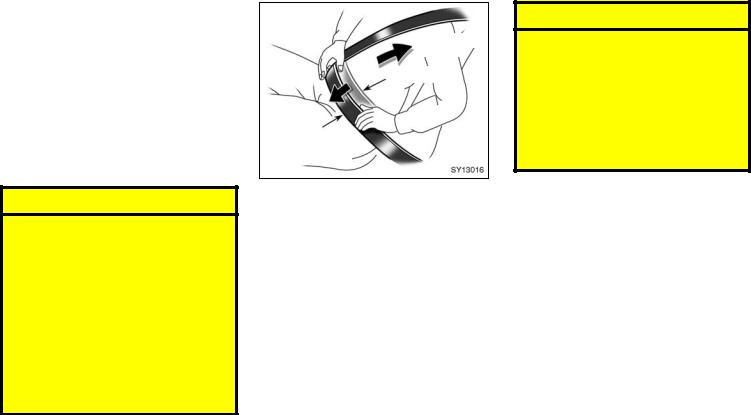
04 05.28
When a passenger’s shoulder belt is completely extended and is then retracted even slightly, the belt is locked in that position and cannot be extended. This feature is used to hold the child restraint system securely. (For details, see “Child restraint” on page 35 in this Section.) To
free |
the belt again, fully retract the belt |
and |
then pull the belt out once more. |
If the seat belt cannot be pulled out of the retractor, firmly pull the belt and release it. You will then be able to smoothly pull the belt out of the retractor.
 CAUTION
CAUTION
DAfter inserting the tab, make sure the tab and buckle are locked and that the belt is not twisted.
DDo not insert coins, clips, etc. in the buckle as this may prevent you from properly latching the tab and buckle.
DIf the seat belt does not function normally, immediately contact your Toyota dealer. Do not use the seat until the seat belt is fixed, because it cannot protect an adult occupant or your child from injury.
Take up slack
Too high
Keep as low on hips as possible
Adjust the position of the lap and shoulder belts.
Position the lap belt as low as possible on your hips—not on your waist, then adjust it to a snug fit by pulling the shoulder portion upward through the latch plate.
 CAUTION
CAUTION
D Both high−positioned lap belts and loose−fitting belts could increase the chance of injury due to sliding under the lap belt during an accident or other unintended event. Keep the lap belt as low on your hips as possible.
DDo not place the shoulder belt under your arm.
2005 ECHO HATCHBACK from Jul. ’04Prod. (OM52624U) |
23 |
|
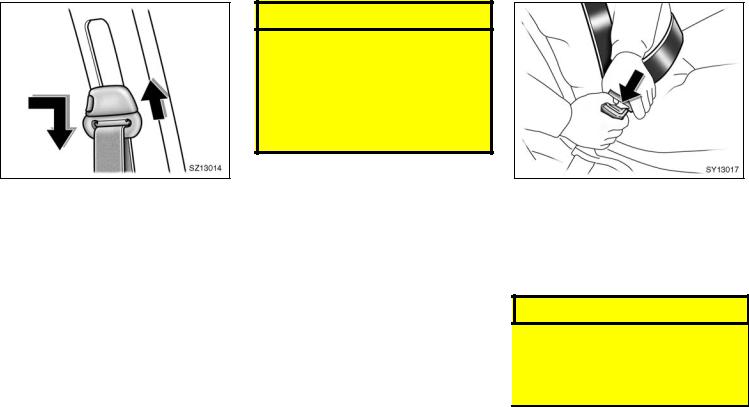
04 05.28
Seat belts with an adjustable shoulder anchor (5−door models)—
Adjust the shoulder anchor position to your size.
To raise: Slide the anchor up.
To lower: Push in the lock release button and slide the anchor down.
After adjustment make sure the anchor is locked in position.
 CAUTION
CAUTION
Always make sure the shoulder belt is positioned across the center of your shoulder. The belt should be kept away from your neck, but not falling off your shoulder. Failure to do so could reduce the amount of protection in an accident and cause serious injures in a collision.
To release the belt, press the buckle release button and allow the belt to retract.
If the belt does not retract smoothly, pull it out and check for kinks or twists. Then make sure it remains untwisted as it retracts.
 CAUTION
CAUTION
Do not separate the buckle with light gray buckle release button. Otherwise, the seat belt may not work properly. See the information in the following columns.
24 |
2005 ECHO HATCHBACK from Jul. ’04Prod. (OM52624U) |
|

04 05.28
—Seat belt extender
If your seat belts cannot be fastened securely because they are not long enough, a personalized seat belt extender is available from your Toyota dealer free of charge.
Please contact your local Toyota dealer so that the dealer can order the proper required length for the extender. Bring the heaviest coat you expect to wear for proper measurement and selection of length. Additional ordering information is available at your Toyota dealer.
 CAUTION
CAUTION
When using the seat belt extender, observe the following precautions. Failure to follow these instructions could reduce the effectiveness of the seat belt restraint system in case of an accident, increasing the chance of personal injury.
DRemember that the extender provided for you may not be safe when used on a different vehicle, for another person, or at a different seating position than the one originally intended.
D Be sure to wear the seat belt |
with- |
out the seat belt extender if |
you |
can fasten the seat belt without the extender.
DDo not use the seat belt extender when installing a child restraint system on the front or rear passenger seat. If installing a child restraint system with the seat belt extender connected to the seat belt, the seat belt will not securely hold the child restraint system, which could cause death or serious injury to the child or other passengers in the event of collision.
To connect the extender to the seat belt, insert the tab into the seat belt buckle so that the “PRESS” signs on the buckle release buttons of the extender and the seat belt are both facing outward as shown.
You will hear a click when the tab locks into the buckle.
When releasing the seat belt, press on the buckle release button on the extender, not on the seat belt. This helps prevent damage to the vehicle interior and extender itself.
When not in use, remove |
the extender |
and store in the vehicle for |
future use. |
2005 ECHO HATCHBACK from Jul. ’04Prod. (OM52624U) |
25 |
|
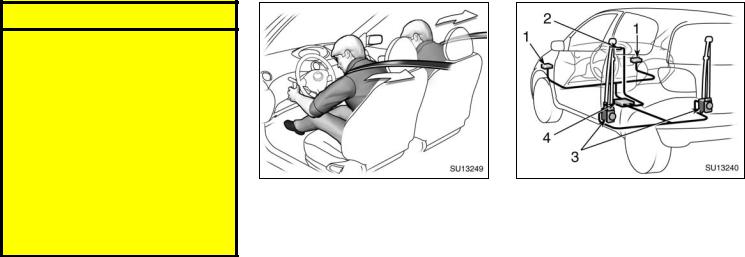
04 05.28
 CAUTION
CAUTION
DAfter inserting the tab, make sure the tab and buckle are locked and that the lap and shoulder portions of the belt and the seat belt extender are not twisted.
DDo not insert coins, clips, etc. in the buckle as this may prevent you from properly latching the tab and buckle.
DIf the seat belt does not function normally, immediately contact your Toyota dealer. Do not use the seat until the seat belt is fixed, because it cannot protect an adult occupant or your child from injury.
—Seat belt pretensioners
The driver and front passenger seat belt pretensioners are designed to be activated in response to a severe frontal impact.
When the sensor detects a severe frontal impact, the front seat belts are quickly drawn back by the retractors so that the belts snugly restrain the occupants.
The seat belt pretensioners are activated even with no passenger in the front seat.
The seat belt pretensioners and SRS airbags may not operate together in all collisions.
The seat belt pretensioner system consists mainly of the following components and their locations are shown in the illustration.
1.Front airbag sensors
2.SRS warning light
3.Seat belt pretensioner assemblies
4.Airbag sensor assembly
The seat belt pretensioners are controlled by the airbag sensor assembly. The airbag sensor assembly consists of a safing sensor and airbag sensor.
26 |
2005 ECHO HATCHBACK from Jul. ’04Prod. (OM52624U) |
|

04 05.28
When the seat belt pretensioners are activated, an operating noise may be heard and a small amount of non−toxic gas may be released. This does not indicate that a fire is occurring. This gas is normally harmless.
Once the seat belt pretensioners have been activated, the seat belt retractors remain locked.
 CAUTION
CAUTION
Do not modify, remove, strike or open the seat belt pretensioner assemblies, airbag sensor or surrounding area or wiring. Failure to follow these instruction may prevent the seat belt pretensioners from activating correctly, cause sudden operation of the system or disable the system, which could result in death or serious injury. Consult your Toyota dealer about any repair and modification.
NOTICE
Do not perform any of the following changes without consulting your Toyota dealer. Such changes can interfere with proper operation of the seat belt pretensioners in some cases.
z Installation of |
electronic |
devices |
such as a mobile two−way radio, |
||
cassette tape |
player or |
compact |
disc player |
|
|
zRepairs on or near the front seat belt retractor assemblies
zModification of the suspension system
zModification of the front end structure
zAttachment of a grille guard (bull bar, kangaroo bar, etc.), snowplow, winches or any other equipment to the front end
zRepairs made on or near the front fenders, front end structure or console
This indicator comes on when the ignition key is turned to the “ON” position. It goes off after about 6 seconds. This means the seat belt pretensioners are operating properly.
This warning light system monitors the airbag sensor assembly, front airbag sensors, seat belt pretensioner assemblies, inflators, warning light, interconnecting wiring and power sources. (For details, see “Service reminder indicators and warning buzzers” on page 69 in Section 1−6.)
If any of the following conditions occurs, this indicates a malfunction of the airbags or seat belt pretensioners. Contact your Toyota dealer as soon as possible.
2005 ECHO HATCHBACK from Jul. ’04Prod. (OM52624U) |
27 |
|

04 05.28
DThe light does not come on when the ignition key is turned to the “ON” position or remains on for more than 6 seconds or flashes.
DThe light comes on or flashes while driving.
DIf any seat belt does not retract or can not be pulled out due to a malfunction or activation of the relevant seat belt pretensioner.
DThe seat belt pretensioner assembly or surrounding area has been damaged.
SRS driver and front passenger airbags
In the following cases, contact your Toyota dealer as soon as possible:
D The front part of the vehicle (shaded in the illustration) was involved in an accident that was not severe enough to cause the seat belt pretensioners to operate.
DEither seat belt pretensioner assembly or surrounding area is scratched, cracked, or otherwise damaged.
The SRS (Supplemental Restraint System) airbags are designed to provide further protection for the driver and front passenger in addition to the primary safety protection provided by the seat belts.
In response to a severe frontal impact, the SRS airbags work together with the seat belts to help reduce injury by inflating. The SRS airbags help reduce injuries mainly to the driver’s or front passenger’s head or chest caused by hitting the vehicle interior. The SRS front passenger airbag is activated even with no passenger in the front seat.
Always wear your seat belt properly.
28 |
2005 ECHO HATCHBACK from Jul. ’04Prod. (OM52624U) |
|

04 05.28
Your vehicle is equipped with a crash sensing and diagnostic module, which will record the use of the seat belt restraint system by the driver and front passenger when the SRS airbags are inflated.
 CAUTION
CAUTION
DThe SRS airbag system is designed only as a supplement to the primary protection of the driver and front passenger seat belt systems. The driver and front passenger can be killed or seriously injured by the inflating airbags if they do not wear
the available seat belts properly.
During sudden |
braking just |
before |
a collision, an |
unrestrained |
driver |
or front passenger can move forward into direct contact with or close proximity to the airbag which may then deploy during the collision. To ensure maximum protection in an accident, the driver and all passengers in the vehicle must wear their seat belts properly. Wearing a seat belt properly during an accident reduces the chances of death or serious injury or being thrown out of the vehicle. For instructions and precautions concerning the seat belt system, see “Seat belts” on page 21 in this Section.
D Improperly seated and/or restrained infants and children can be killed or seriously injured by the deploying airbags. An infant or child who is too small to use a seat belt should be properly secured using a child restraint system. Toyota strongly recommends that all infants and children be placed in the rear seat of the vehicle and properly restrained. The rear seat is the safest for infants and children. For instructions concerning the installation of a child restraint system, see “Child restraint” on page 35 in this Section.
2005 ECHO HATCHBACK from Jul. ’04Prod. (OM52624U) |
29 |
|

04 05.28
The SRS airbags are designed to deploy in severe (usually frontal) collisions where the magnitude and duration of the forward deceleration of the vehicle exceeds the designed threshold level.
The SRS airbags will deploy if the severity of the impact is above the designed threshold level, comparable to an approximate 30 km/h (18 mph) collision when the vehicle has the impact straight into a fixed barrier that does not move or deform.
However, this threshold velocity will be considerably higher if the vehicle strikes an object, such as a parked vehicle or sign pole, which can move or deform on impact, or if the vehicle is involved in an underride collision (e.g. a collision in which the front of the vehicle “underrides”, or goes under, the bed of a truck, etc.).
It is possible that in some collisions where the forward deceleration of the vehicle is very close to the designed threshold level, the SRS airbags and the seat belt pretensioners may not activate together.
Always wear your seat belts properly.
Collision from the rear
Collision from the side
Vehicle rollover
Hitting a curb, |
Falling into or |
|
edge of pavement |
||
jumping over a |
||
or hard surface |
||
deep hole |
||
|
Landing hard or vehicle falling
The SRS airbags are generally not designed to inflate if the vehicle is involved in a side or rear collision, if it rolls over, or if it is involved in a low− speed frontal collision. But, whenever a collision of any type causes sufficient forward deceleration of the vehicle, deployment of the SRS airbags may occur.
The SRS airbags may also deploy if a serious impact occurs to the underside of your vehicle. Some examples are shown in the illustration.
30 |
2005 ECHO HATCHBACK from Jul. ’04Prod. (OM52624U) |
|
